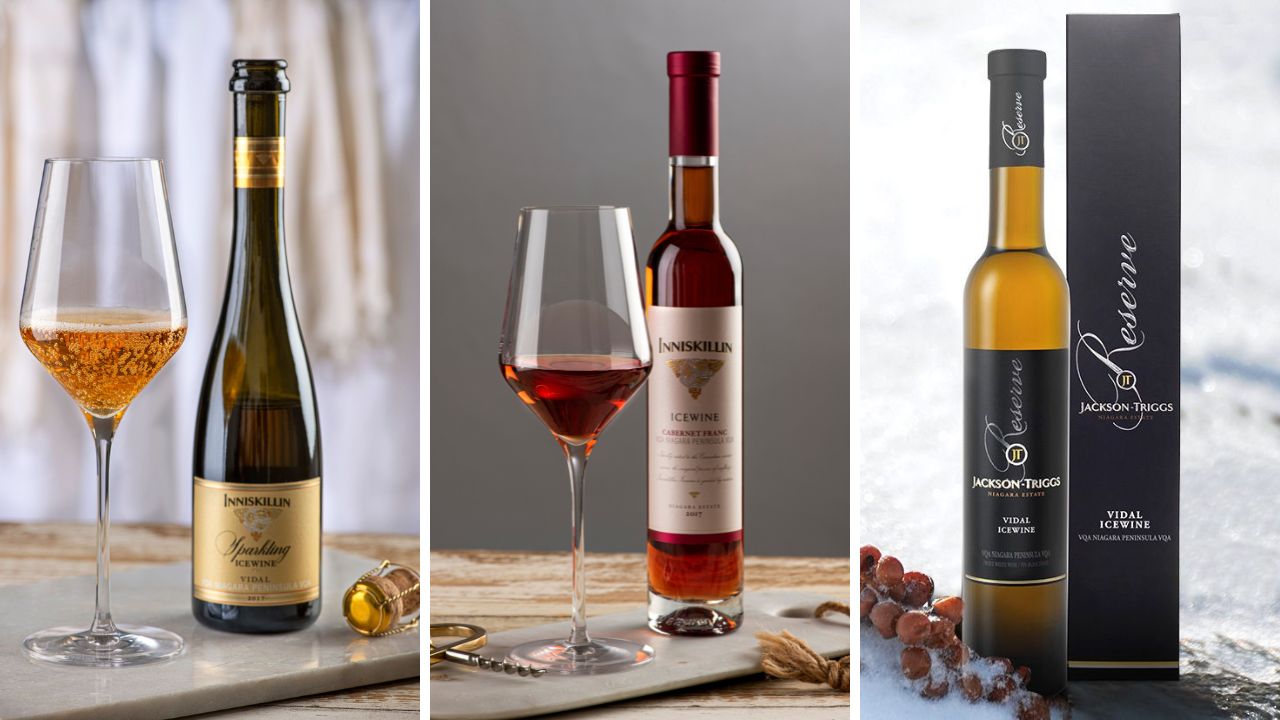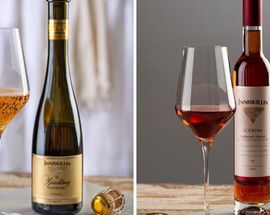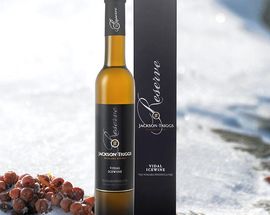
What is special about Icewine?
Icewine is truly Mother Nature’s Wine. In exceptionally unique circumstances, where you have warm summers (to allow healthy grapes to fully ripen) and very cold winters, where the temperature consistently drops to at least minus 8 degrees Celsius, you can make a very rare and exquisite wine–called Icewine. There are only three countries that can make Icewine on a regular basis – Germany, Austria, and of course, Canada where we get all the Icewines in our portfolio. It is important to note that grapes are mostly water and when that water freezes solid, you are left with a very intense and concentrated nectar that is balanced by precise and thrilling acidity. It is this fine precise balance of natural sweetness and acidity, and inherent purity that makes Icewine so very special. The acidity helps cleanse the palate and balance the sweetness, which makes it ideal as pairing wine with many dishes, both savoury and sweet.
Tell us about how Icewine became what it is today?
The first Icewine or Eiswein as it is known in Europe was made by accident... In Germany in a region of Franconia, some monks went on a week-long-excursion and when they returned to their monastery, they realized that an early winter storm had come through and frozen their vineyard. They thought that their crop was lost, but decided to harvest and crush it anyway... the results are now famous – The first Eiswein, and now more than 200 years later, Icewine is celebrated as a specialty wine. The problem is that it is and always will be a very risky proposition to leave vineyards unharvested’ – and as a result, Icewine was only made 10 times in Germany until 1962 (where they do not consistently have cold enough winters to produce Eiswein on a regular basis – including this vintage). As such, Eiswein was never officially categorized until 1983, but now takes its place as the single most sought-after wine in Germany, commanding hundreds of dollars per bottle – when it is made.
"The acidity helps cleanse the palate and balance the sweetness, which makes it ideal as pairing wine with many dishes, both savoury and sweet."
Why bring Icewine to South Africa?
Essentially I started Icewine Africa after noticing the unavailability of Icewine brands in a well-established wine market like South Africa. The idea to distribute Icewine came about in 2018 when I was introduced to it by a friend of mine who had traveled to Canada. I immediately found huge interest in this wine style and after that, I researched it. I was so intrigued by the production process of Icewine and of course the sexy appeal of the Icewine bottle packaging. To cut the long story short, I took it upon myself to bring this specialty drink to our shores to be enjoyed and to establish a commercial footing in Sub-Saharan Africa
Who is making Icewine?
While Germany invented Icewine; Canadians perfected the art of producing it. Because Canada has regular suitable weather conditions for the production of Icewine, Canada now produces over 90% of global production. As the second coldest country in the world, Canada certainly has the climate to make this very special and unique wine on a consistent basis. Although Canada is quite large in landmass, there are only four regions that house wine-making vineyards. Inniskillin was one of the pioneers in Ontario to produce Icewine and the region is now the largest producer of Canadian Icewines. Production in Canada is heavily regulated. The law stipulates that grapes must be harvested after they have been naturally frozen on the vine at minus 8*C or lower. In Germany, it’s set at minus 7*C. Icewine making is also found in the US, Austria, Switzerland, Hungary, Poland, and France but the climate in some of these countries is warmer, and usually they don’t get the sustainable suitable winter temperatures needed for production.
Who else in the world is drinking Icewine?
Icewine is expensive, but when you consider that you only need a small amount to satisfy, a half bottle goes a long way – and makes a HUGE impression as a gift or a treat at the end of a special dinner. Icewine is enjoyed all over the world at different settings, whether it’s in fine dining luxury restaurants or at private dinner parties or for home consumption and contrary to the belief, Icewine is not just a dessert wine. You can enjoy it paired with an entrée, as an aperitif (usually Sparkling Icewines) and of course paired with a semi-sweet dessert. It's just a delicious luxurious drink – best served well-chilled.
The first Icewine or Eiswein as it is known in Europe was made by accident... In Germany in a region of Franconia, some monks went on a week-long-excursion and when they returned to their monastery, they realized that an early winter storm had come through and frozen their vineyard. They thought that their crop was lost, but decided to harvest and crush it anyway... the results are now famous.

For wine novices–can you tell us more about the grapes and the process used to make Icewine?
World Wide Icewine comes in a variety of styles made from a variety of grapes so there is a whole world out there for food pairings. There are however the Top 4 Grape varietals that are commonly used – the most popular varieties are Vidal Blanc, Riesling, CabernetFranc andGewürztraminer. Some small lots include Chardonnay and Cabernet Sauvignon but the four varietals mentioned first consistently produce the best results.
How many Icewine makers are there – can you share some of the labels to look our for?
Quite a number – in North America, Europe, and now recently in some Asian countries like Japan. We are the exclusive distributors of Inniskillin, which was recognized as one of the World’s Most Admired Wine Brands by drinks International and is the most recognized Icewine, sold in more than 94 countries. We also distribute Jackson-Triggs Icewines (awarded the best Canadian Winery 26 times in Global Competitions) and Sawmill Creek Icewines, produced by acclaimed winemaker Bruce Nicolson. These labels are well-known for their reputation, quality, luxury, consistency, and history.
Can you age Icewine, or is it a "drink today" wine?
Without a doubt, Icewine like any other wine can age gracefully if stored properly. It’s a matter of preference if one would like to enjoy drinking it while it’s still young, fresh, and crisp, or store it and enjoy it at a later time.
What is best paired with Icewine?
Traditionally Icewine is enjoyed as a dessert or with dessert. Over the years it has proven to be a perfect complement for rich, strongly flavoured foods such as foie gras and aged blue cheese. It also pairs well with spicy, sweet, and savoury flavours like lemon-butter seafood.
What's the price range that should one expect to pay for a bottle?
The average price for a good bottle of 375ml premium Icewine, would be between R900 and R1300. It is tremendously intense and concentrated, but tremendously expensive to make as well. On average 4.5 kilograms of grapes are needed to make one small bottle of 375ml; the yields are typically 5-15% of the yields that you would get if you were making table wines. That is why Icewine costs are high and heavily regulated.
Book your tickets now on Webtickets to mingle with award-winning winemakers and fellow wine enthusiasts at WineX 2022.







Comments